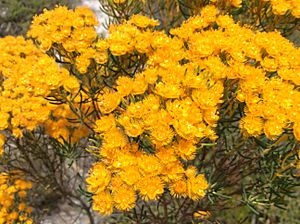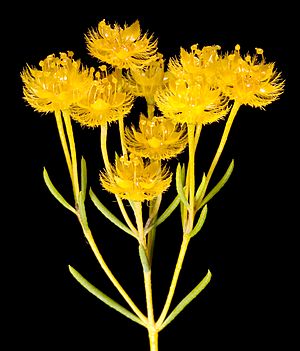Christmas Morrison facts for kids
Quick facts for kids Christmas Morrison |
|
|---|---|
 |
|
| V. nitens growing near Gingin | |
| Scientific classification | |
| Genus: |
Verticordia
|
| Species: |
nitens
|
| Synonyms | |
|
Chrysorhoe nitens Lindl. |
|
Verticordia nitens, often called Christmas Morrison, is a beautiful flowering plant from the myrtle family. It grows only in the south-west part of Western Australia. The Noongar people, who are the traditional owners of the land, call this plant kotyeningara.
This plant is a tall shrub with shiny, sweet-smelling flowers. These flowers bloom between October and February, making them a special sight around Christmas time in Australia. Even though it grows near big cities like Perth, the Christmas Morrison plant is not considered rare. There are still many of them, even though some areas have been lost due to city growth.
Contents
What is Christmas Morrison?
How Does it Look?
Verticordia nitens is a shrub that usually grows to be about 0.45 to 1.8 meters (1.5 to 6 feet) tall. Sometimes, especially near Gingin, it can even reach 3 meters (10 feet) high! It can also spread out to about 0.9 meters (3 feet) wide.
Unlike some other plants, it doesn't have a special woody base called a lignotuber that helps it regrow after fires. Its branches are thin, and its leaves are like soft needles, about 15 to 25 millimeters (0.6 to 1 inch) long.
The flowers have a lovely scent and grow in bunches at the ends of the branches. Each flower sits on a small stalk. The flowers can be bright golden, orange, or even lemon yellow, especially the taller plants in the Gingin area. The flowers have feathery parts called sepals and petals with tiny teeth.
Why is it Called Christmas Morrison?
The first official description of this plant was made by John Lindley in 1837. He called it Chrysorhoe nitens. Later, in 1838, Stephan Endlicher changed its name to Verticordia nitens, which is the name we use today.
The common name "Christmas Morrison" comes from a gardener named William Morrison. He was asked to collect plants from Western Australia to send to England. He couldn't remember the plant's scientific name, so he just labeled it with his own name. This is how "Morrison flower" became a common name for this and similar plants. The plant is also called "Christmas Morrison" because its bright, golden flowers bloom around Christmas.
Where Does it Grow?
Verticordia nitens grows in sandy areas, often in Banksia woodlands. You can find it as far north as the Moore River and as far south as Yarloop. It often grows alongside the Western Australian Christmas Tree, called Nuytsia floribunda, because both plants have bright orange flowers. City growth around Perth has caused the plant to grow in separate groups, both north and south of the city.
How Does it Survive?
Interestingly, Verticordia nitens flowers are not very attractive to common insects. Instead, they are pollinated by a special type of solitary bee called Euryglossa morrisonii. This bee feeds on the nectar, pollen, and oil from the plant's flowers.
This plant is not in danger of disappearing because there are still many large groups of them. People sometimes harvest the flowers for the cut flower industry. Even though many flowers are picked, the plant usually grows back well. However, it's important that harvesting is done carefully so that local plant groups can recover and continue to produce seeds.
The plant can be affected by a plant disease called Phytophthora cinnamomi. Scientists sometimes use Verticordia nitens to check if this disease is present in an area.
Growing This Plant
Gardeners in England were very excited about growing Verticordia nitens because of its "strikingly beautiful" flowers. However, it was quite difficult to grow outside of its natural home. It was first brought to English gardens in 1840, but it didn't flower there until 1861!
It has been a bit more successful when grown in eastern Australia, thanks to better growing methods and early pruning. Early attempts to grow it often failed because the seeds didn't sprout well, or the plants didn't grow to maturity.
Today, people mostly grow Verticordia nitens from cuttings, which are small pieces of the plant. It's rare to get seedlings from cultivated gardens because the special bee that pollinates it isn't usually there. The plant can also be sensitive to certain plant diseases, especially in wet or dry conditions. Gardeners have learned that pruning the plant can help it become bushier and stronger.
Uses and Art
Besides its traditional names, Verticordia nitens is also known by common names like Glistening Verticordia, Morrison Featherflower, and Orange or Yellow Morrison.
This plant has been featured in many artworks. For example, it was painted by Constance Miller in 1912 and Emily Pelloe in 1925. It was also included in Gardner's West Australian Wildflowers in 1935, which was one of the first books to show full-color photos of these flowers.
Verticordia nitens is often dried and used in arts and crafts. Its beautiful flowers and leaves are used in things like resin art, small decorative trees, or even cake decorations. The flowering stems are popular for flower arranging and are used locally as a "Western Australian [[Christmas decoration|Christmas" decoration. The cut flowers keep their color and scent for a long time, sometimes up to 12 months! This makes them very popular for the cut flower industry in Western Australia.
Images for kids
-
Verticordia nitens in a winter-wet area north of Ellenbrook
-
Plate 1 from John Lindley's A Sketch of the Vegetation of the Swan River Colony: "Chrysorhoe nitens"






